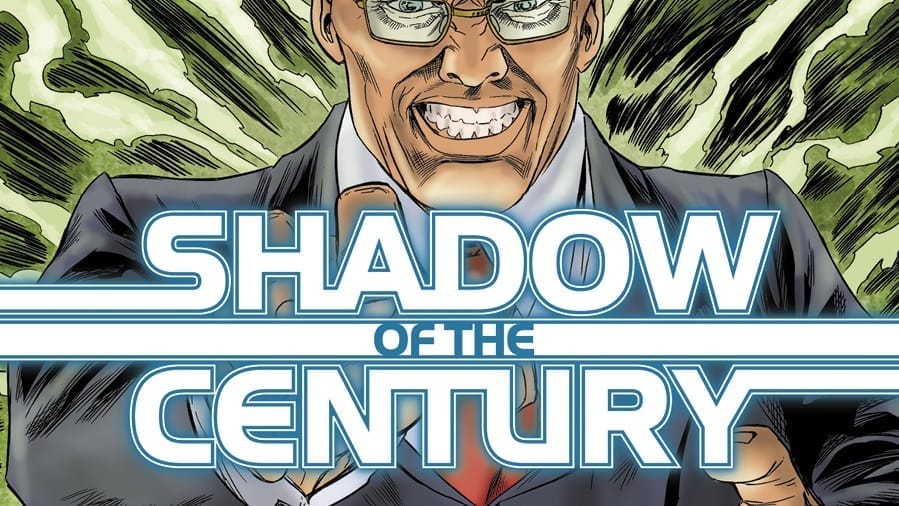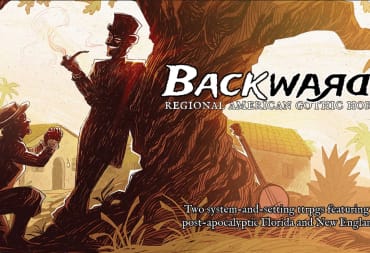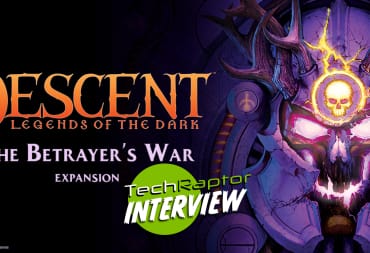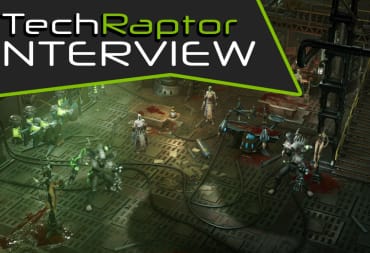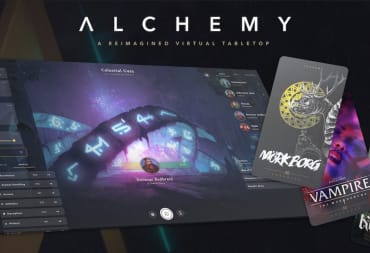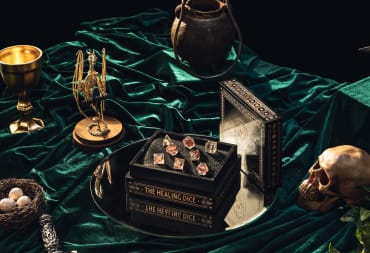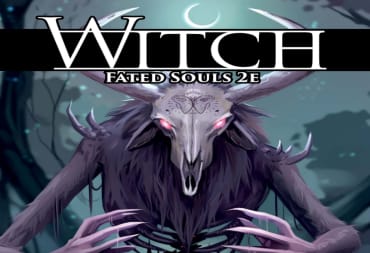Back in 2013, Evil Hat Productions launched a Kickstarter to develop the next edition of the FATE system, dubbed Fate Core. Among the stretch goals for the project was the promise to develop Shadow of the Century, a follow-up to the acclaimed Spirit of the Century that brings the setting forward into the pulpy action and adventure of the 1980s. It's finally out now, so I sat down with designers Mike Olson and Morgan Ellis to talk about Shadow of the Century, '80s action, and Hazzard County's infrastructure.
TechRaptor: Shadow of the Century. So Spirit of the Century was obviously known for having these pulp heroes and action, so how have you evolved those themes to match this new 1980s era that Shadow of the Century is taking place in?
Morgan Ellis: Well Spirit of the Century was based on the pulp novels of the ‘20s and ‘30s, so those were the heroes, those were the action stars. It was very simple to then just say “Shadow of the Century is in the ‘80s”, so you look to the action movies and action television and what was happening in the ‘80s and adventure stories. You know, just look to all those weird ‘80s shows that if you look on Youtube you can find their opening credits and you’d be like “What the hell, I barely remember that show but that was weird, that was cool and awesome!” And you can play to those things rather than looking to the pulps. You go “Oh yeah, Manimal and Automan and Street Hawk” and all those weird adventure heroes that we barely remember from the '80s—or maybe you remember them very well—but that’s who you get excited about to play. And you know there are the big names: the A-Team, Knight Rider, and things like that that are a little more accessible but there are also those other weird ones that you can look to.
Mike Olson: '80s had pulp too, like it’s just '80s pulp adventure versus '20s pulp adventure. But there’s a lot of similarity in terms of tone, I think, between pulp adventure in the '20s and '80s. So it was not difficult at all to imagine that. It helps that for Morgan and myself and a ton of other people, as soon as we got Spirit of the Century we started hacking it do other stuff. You know the idea of “let’s do something else with Spirit” has been like in our blood since 2006.
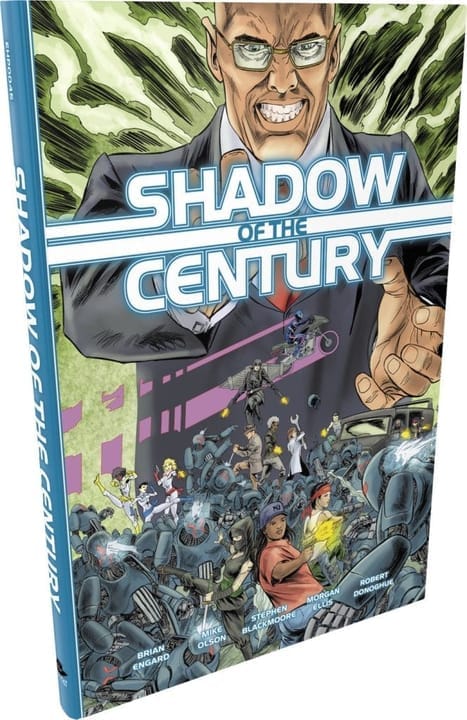
TechRaptor: So were you guys both big players of Spirit of the Century before you even worked on Shadow?
Mike: Yeah, that’s how we met actually!
Morgan: Yeah.
TechRaptor: Oh really?
Mike: Morgan and I would make hacks of Spirit of the Century because at the time there wasn’t a standalone Fate thing, so it was all just hacks of Spirit. So we would hack Spirit of the Century and run games at local conventions in LA. And we’d play in each other’s games because we kept doing it like 3 times a year. We’d show up with some new hack and do another thing with Spirit of the Century.
Morgan: Yeah Mike had Spirit of the Blank where you could find all these different Spirit of the ..., because that was the format of the time since it wasn’t Fate Core, it was Spirit of the … And then you’d put in your own spin on what you were using the Spirit of the Century mechanics to do.
Mike: Spirit of the Blank or Blank of the Century, those were the only two ways you could [name it] [laughs]. Morgan had Spirit of the Shattered Earth. I did Spirit of the 31st Century, that’s my Futurama hack, and Spirit of the West. A friend of ours ran a Star Wars game that we called Spirit of the Force, and it was just on and on and on.
Morgan: Spirit of the Red Planet which was a John Carter of Mars hack. That was fun.
TechRaptor: I can imagine, yeah. So how did you two end up with Evil Hat then, making an official Blank of the Century?
Mike: Well Morgan was at Evil Hat First.
Morgan: Well I would run games and I would do stat blocking for a lot of Dresden Files when it first came out—the original, pre Fate Core Dresden Files. I was there as an Evil Haberdasher at Origins [Game Fair] running like six games for them and sort of got to know the people from Evil Hat online first and then in-person, and it just kind of snowballed from there and running games and doing stat blocking for them. And then Mike, Spirit of the Blank led you to a couple of things and that led you to Evil Hat, right?
Mike: Yeah, I had done some other things with Fate and then Brian Clevinger and Scott Wegener from Atomic Robo contacted me about making an Atomic Robo roleplaying game. And then I got excited about doing that and then shortly after that Fred Hicks told Brian on Twitter that Evil Hat sure liked Atomic Robo, and then Brian told me “I may have talked about Fred Hicks with this on Twitter a little bit” and I was like “Oh god I’m going to lose this thing! Evil Hat is going to take this thing away from me! Why wouldn’t you go with Evil Hat over just some guy?”
So I got on Twitter and I was like “Hey guys what’re we talking about?” and Fred Hicks being such a good guy was like “Yes, let’s publish this and let’s bring Mike on to do it”. He kept me as part of it as the writer, so that was very nice of him. He easily could have said “We’ll take this. Thanks. We have an established thing and we’ll do it.” So that’s how I ended up doing stuff for Evil Hat and then while Atomic Robo was in development then I got asked to work on Fate Core. So I was developing Atomic Robo and Fate Core at the same time, and Atomic Robo was supposed to be based on Fate Core, so as Fate Core changed Atomic Robo changed too, so it was a complicated month between Gen Con and San Diego Comic Con. A bunch of things changed. I just remember a lot of frantic rewriting of things to try to keep up. But anyway, that’s how that happened and Morgan and I have been doing stuff and working on Shadow of the Century since 2015.
Morgan: 2014, 2015, somewhere in there, yeah.
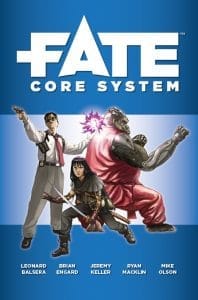
TechRaptor: Yeah, because wasn’t that part of the [Fate Core] Kickstarter from 2013?
Morgan: Yeah it was, it was the very end of 2013. I’m pretty sure Rob [Donoghue] and Fred [Hicks] they have like an even further one. They wanted to kind of do a Buck Rogers Spirit after it, so kind of a Spirit follow-up where it’s off in the next millennium and you’re off doing space adventures. I think that was their plan back in the day, but they had the idea of Shadow of the Century for quite a while. They wanted to do the '80s and they thought that’d be cool. And that was the very last stretch goal in the Kickstarter for Fate Core, but I think they said “Yeah, hey, we’ll do this Shadow thing that we’ve always wanted to kind of do” and then about 2014-2015 is when we all started and it was just working on it, working on it, working on it, throwing things at it, changing it up, and I guess Mike was on it first and he said “Hey we gotta get Morgan on this, why is he not here?”
Mike: Yeah, that was ludicrous to me. Morgan is the ideal person to have on a game about '80s TV shows and movies. He’s a walking encyclopedia of that sort of thing.
TechRaptor: So speaking of which, were there any movies and TV shows in particular that really influenced you while trying to do this? Like any that you were really trying to capture that feel of?
Morgan: Again, I don’t know if there were any [ones in particular], but we would do this thing where we had this big inspiration document of some of the shows or some movies, and we’d go through and add all these movies and we would go “What was that thing with the guy, that kid who turned into a car, what the hell was the name of that one?” and I would do some research or just know it and put it on the list. I think definitely Manimal, Automan, and Jack Burton, right? If we could make a game that would do all those characters and then also be able to let them team up we knew we were in the right zone, if that makes any sense. It’s so weird to think about it, but that was kind of the goal was to get those characters that were just gonzo '80s action TV or movie crazy. There are some shows that you just go “Wow, that was just perfect inspiration”. There’s a really weird one called the Eliminators which has a cyborg, and a ninja, and a river boat pirate and it’s just this weird-ass movie.
Mike: I just wanted a Buckaroo Banzai game.
Morgan: Yeah, but you’d already written Robo though, but that was fun. [laughs]
Mike: [laughs] But I wanted a Buckaroo Banzai game. Yeah things I think of are A-Team and Airwolf, but yeah really Buckaroo Banzai and that inspiration document—like half of it was Kurt Russel movies. There’s just a ton of Kurt Russel movies on that list.
TechRaptor: Nice.
Morgan: What would Kurt Russel do? [laughs] That was kind of the question.
TechRaptor: That’s a good motto for any project.
Morgan: I think so.
TechRaptor: So can you talk a bit about the new mechanics that we’ll be seeing in the new book? Or that we are seeing now that it’s out.
Mike: Well, the best mechanical thing, I think, about Shadow is the Roles, which I think is a very nice refinement of Modes from Atomic Robo. It’s the same idea, but not as complicated because I wasn’t in charge of it [laughs]. Brian Engard came up with Roles. Basically there are 16 Roles in the game—stuff like Brain, Face, Hacker, Ninja—and you pick three of them for your character. So you can express your character in terms of 3 things, like what are the three of these Roles that would apply to this character. And each Role comes with 4 Skills, and for each instance of a Skill that you get from Roles is +1 to a Skill. So if 2 roles give you Fight, then you have +2 to Fight. If all 3 of them give Awareness, you have +3 to your Awareness, that sort of thing. After that you have 8 points you can spend on Skills in general. You can spend them on improving Skills you already have or giving yourself new Skills, whatever. But it’s a very quick way to build the character that has the same idea as Modes, which is pick 3 things that your character is about. And it’s very nice, I like it a lot. And each [Role] has 6 Stunts that are written for it and the idea is you only pick Stunts that are attached to one of your [Roles]. So there is both the big list of Stunts that people seem to like and also not a big list to think about, because you’re really only looking at 18 Stunts. Not that you can’t make your own Stunts, but if you just pick from those lists you will always have Stunts that are applicable to your thing and you won’t have to go too far to be able to find them. So I really like the Roles bit a lot.
Morgan: And one thing that I like is the Gonzo stunts with the Gonzo characters, who are the superheroes—or they are the '80s level superheroes in those action TV shows and action movies where you’re not Superman but you’re definitely a cut above even the average action hero. And I really like the way that gets expressed and that’s the way that Shadows and Spirits work: they have extra abilities and Stunts that are within their own little space. I actually played a fun Spirit character in a game Mike ran at a convention a couple months ago called S.T.I.N.G.R.A.Y. I think Mike has the acronym of what the boat is.
Mike: Seaborn Tactical Intercontinental Nautical Grade Rudderless Aquatic Yacht [laughs]. That’s not my thing, that’s from Matt Gourley and James Bladon. This is a very obscure thing I took it from. Matt Gourley and James Bladon are two improvisers and musicians and they made a series of TV theme songs to TV shows that don’t exist. They put them on Soundcloud and asked people to make titles sequences for them, and one of them was this one for S.T.I.N.G.R.A.Y., which is like A-Team on the ocean or something, and when I heard it I was like “That’s gotta be a Shadow of the Century game.” And two years later I did it [laughs].
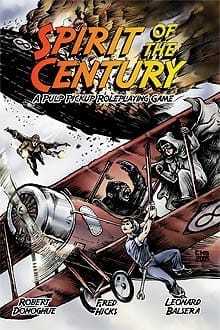
Morgan: So I played the Spirit who was an old sailor who was a crusty old sea dog and had all sorts of neat special abilities. And I like that range and that you can just pick the roles and go with the standard new-age hero or you can go to somebody who’s maybe even gotten a little bit more powerful and gotten a little bit of the weirdness of the setting in them. You can have a living hologram or a guy with a time watch, there’s all sorts of stuff. Digital time watch, that’d be a real good power and set, or I’ve got a car, I’ve got talking car, it’s a robot car. It’s great, it does all sorts of things. And I think it’s the fun range you can get out of combining the roles and the simpleness of the character creation and also you can just go wild and go gonzo.
TechRaptor: Yeah, I love how you really incorporate the absurd action into the game mechanics. Like in my notes for when I was researching this I put in big capital letters “GONZOMETER." I thought that was such a cool idea to have the GM be able to set an absurdity to a scene.
Morgan: Yes, do you want to bury the needle on your Gonzometer? [laughs] Yeah, that was an early concept that really helped hone in on what we wanted to do with the game. Rob Donoghue came up with Variable Hyperdimensional Simultaneity, or VHS, as a way to express what’s going on in the universe. The deep, deep background story is that Doctor Methuselah, one of the big bads from Spirit of the Century, has basically spent the last who-knows-how-long-but-a-very-long-time rewinding and doing-over the last 20-so years of the century. So he goes back to the '80s, starts it up again, goes back, starts it up, “Nah it didn’t quite work the way I wanted it to”, and keeps going back and redoing it. And reality is like a video tape, so all those little bits and pieces from previous realities start going through and bleeding over [kind of like] what happened if you redubbed the video tape again and again and again, you’d get little artifacts from previous things. So that was a main thing, and that led to the Gonzometer and where you want to set it. Do you want just a normal straight action '80s show, or do you want to make this [like] it’s a normal action show but there’s also weird magic kung-fu, or do you want to go “there are robots and magic is wild and everything and ninjas that have elemental powers!" All those things can start bleeding over into reality because they’ve already happened and now they’ve been intruding, and that sets the Gonzometer for the GM to say “How wacky do I want this thing to be? How wild and crazy?”
TechRaptor: The answer is yes, I always want ninjas. [laughs]
Morgan: Who wouldn’t.
Mike: It’s a handy thing to put front and center too for the people...We talk a lot about over the top this, over the top that, but the Gonzometer ensures that it doesn’t have to be that way if you don’t want it to be. That was something I heard a lot of people say about Atomic Robo was that “Oh it’s just so over the top” and I’m like “Well it can be, it can be really crazy, but it doesn’t have to be”. And in Shadow you can play that A-Team level game where things aren’t crazy. They’re implausible, but they’re not crazy. But yes, you can turn a tractor to a battle tractor and save locals from whatever’s threatening them, but it doesn’t have to be this robot ninjas stuff all the time if you don’t want it to be. Or if you do want it to be it absolutely can [laughs]. But I like that the Gonzometer really places front and center the idea that there’s lots of stuff in this book that you have control over the level of how over the top you want to get. If you want to be under the top, that’s fine.
Morgan: Yeah, if you want like an Equalizer level, or you want like a Magnum P.I. We’re just normal guys guys with normal cars, just normal action training, they didn’t turn buses into improvised tanks with a montage, but they had fun and they could totally have action adventure and do cool things with vehicles. But they weren’t taking that next extra step of the A-Team. Or like Dukes of Hazzard right? They didn’t jump things on a regular basis. [laughs]
TechRaptor: [Dukes of Hazzard] was wrecking too many cars for that.
Mike: Hazzard County had a lot of ramps.
Morgan: Well they had a lot of road construction on those dirt roads that require lots of piled up dirt.
TechRaptor: Yeah, those country roads are hard to maintain.
Morgan: They are. Especially when all the money’s being siphoned off by corrupt politicians and sheriff’s departments.
Mike: It’s all about urban planning.
Morgan: Yes, that’s really the secret key to Shadow of the Century: where did you put the ramps in your city?
TechRaptor: This next question is from my editor Don. So this is the final book from the Fate Core Kickstarter back in 2013, so looking back over the last few years he wants to know what thoughts you have about the work you’ve done on Fate Core or on Fate Accelerated.
Mike: That Kickstarter has kept me working as a freelancer for the past 5.5 years or whatever, that was amazing. You know at the time it was a huge huge amount of money that Fate Core raised for that Kickstarter and I think it’s all been put to very good use. I would say that, I got some of it [laughs]. Now Kickstarters for RPGs can hit in the millions now, it’s crazy. But I think we’ve gotten so much value out of that one Kickstarter, it’s been really great. But what’s one of the best things about it is that first of all it really changed what kind of company Evil Hat could be, which is really cool. All of the Fate Worlds and Adventures that have come out of it has been really awesome, a bunch of pay-what-you-want 50- page settings and adventures with the mechanics—there’s some fun in there that you could extract if you want to. And then also the mentorship program that they’ve done to try to bring new people who have good ideas and haven’t written before but they want to—
Morgan: Who’ve never written Fate before.
Mike: Right, that’s an important distinction. … But the whole mentorship where you take someone who doesn’t have a lot of experience writing for Fate and you pair them up with someone who’s an established writer for Evil Hat and then together they get to make a game, and then that new person is now a published writer, I think that’s so cool. And they’ve really focused on bringing in diverse voices that way, like Lore Graham and Felipe Real who I did a book with. He’s Argentinian and he wrote a game [The Way of the Pukona] about a native community in Argentina that no one outside of Argentina probably is familiar with. But like he’s in a position to write about these indigenous people in a very fictionalized way that I just think was so cool. Like no one else could have done that. And because of Evil Hat he was able to make a game out of that; that’s really awesome.
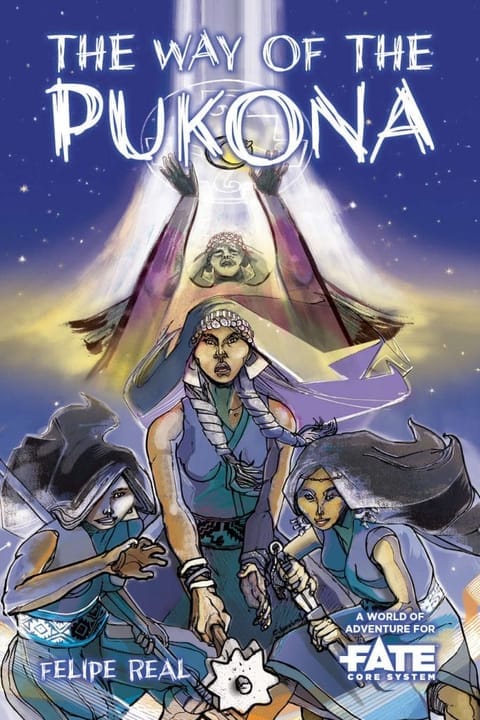
TechRaptor: So that mentorship program, that came out of the Kickstarter too?
Mike: It wasn’t explicitly a part of it but the Kickstarter gave Evil Hat the financial infrastructure to be able to do things like that. And I think that’s so awesome.
TechRaptor: That is great.
Morgan: I actually have only really worked on Shadow of the Century, that was the only thing I worked on that was actually part of the Fate Core Kickstarter. I’ve certainly used [the Kickstarter books] as a resource, especially Jess Nevins’ Strange Tales of the Century, which bridges the gap—it goes I think up until the late '50s maybe the early '60s in the Shadow world. Because he’s the two-fisted pulp scholar and he does every sort of pulp character and goes through the list and here’s all the archetypes and here’s all the ideas and then expanded the fictionalized universe of the Spirit of the Century universe. And we actually incorporated some of that stuff back into Shadow, because we’re looking at the timeline of this thing and what’s going on during the war, what’s going on the in the '50s. “Well let’s look at this book”, so that’s very helpful. And yeah, it’s just been great to see all those worlds take off and it’s certainly given me a lot more to play. I no longer need to make my own Spirit of the Blank hacks because more than likely there is a setting that already does it and it’s already been put out or I can easily file some serial numbers off and make it the thing that I want to make. It’s much less work for me, more work for Mike [laughs].
Mike: It was an amazing relief for me putting together that S.T.I.N.G.R.A.Y. game because I’ve just been like a mechanics guy for the whole development of Shadow, but when I realized “Oh of course, there’s a setting here. I just use the setting, I don’t have make up anything!” [laughs] There’s actually a really cool interesting setting with already a bunch of appropriate antagonists. There’s a weird of moment of like “Oh, I don’t have to come up with everything here, there’s an entire setting to work with.” It was a relief.
TechRaptor: Yeah, you guys at Evil Hat have such an expansive collection of these products, there’s just so much here from all these different eras. You really can just pick up wherever you want.
Mike: Yeah, that’s what’s been keeping me busy at Evil Hat is system developing these Fate Worlds and it’s really cool to see what someone can cram into a relatively small word count and get out there, and I think it’s amazing how many they’ve managed to put together and release into the world.
TechRaptor: Alright, well that’s pretty much all the questions that I needed answered. Really, thank you guys for so much for taking the time to talk.
Shadow of the Century was released on February 19, 2019. You can learn more about the Fate Core supplement over on Evil Hat's website.
Have a tip, or want to point out something we missed? Leave a Comment or e-mail us at tips@techraptor.net
